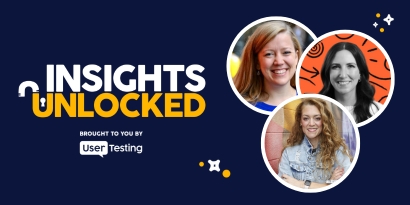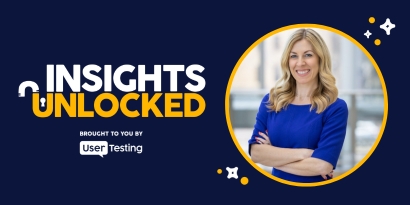
Episode 144 | November 11, 2024
Transforming customer experience with responsible AI strategy
Discover how Sharbani Dhar’s problem-first approach to AI helps companies transform customer experience with responsible, human-centered design strategies.
Transforming customer experience with responsible AI strategy
Many organizations, says Sharbani Dhar, are missing the mark on AI by focusing too much on the technology instead of their true customer needs.
As AI continues reshaping industries, many organizations struggle to make it work for the customer experience. Too often, businesses rush to adopt AI solutions without a clear focus on the real problems they aim to solve.
Sharbani—CEO of Infinity and former design director at Australia Post—sheds light on this issue in a recent Insights Unlocked episode.
“It’s not just about making things look good—it’s about creating meaningful experiences that drive real impact,” Sharbani explains. Her approach prioritizes a “problem-first” mindset that keeps customers at the core, aligning AI initiatives with true business outcomes.
Moving from tech-first to problem-first approach in AI adoption
Many companies adopt AI simply to keep up with the latest tech trends. However, Sharbani warns that a tech-first approach often leads to missed opportunities and wasted resources. “When you look at AI implementation, the question shouldn’t be, ‘What’s the latest technology?’ but rather, ‘What problem are we trying to solve?’” she says.
To anchor that point, Sharbani cited a recent study showing that, while 63% of companies invest in AI-led initiatives, only 45% see measurable returns.

She advocates for starting with a clear understanding of the core issues that need addressing. By focusing on customer needs first, organizations can avoid the trap of using AI in ways that add little value. A problem-first approach ensures that AI efforts support customer-centric objectives, leading to sustainable, impactful results.
“When you look at AI implementation, the question shouldn’t be, ‘What’s the latest technology?’ but rather, ‘What problem are we trying to solve?’”—Sharbani Dhar
Aligning AI with customer-centric metrics
One of the most common pitfalls in customer experience is an over-reliance on metrics that don’t reveal the full picture. For example, many companies still rely on the Net Promoter Score (NPS), which Sharbani argues falls short. “NPS tells us how likely customers are to recommend a product, but it doesn’t reveal the whole story,” she notes.

Instead, Sharbani suggests adopting metrics that reflect true customer engagement, brand loyalty, and trust. With this approach, organizations can better understand how AI impacts the customer journey and make informed decisions that benefit both the business and its audience.
“NPS tells us how likely customers are to recommend a product, but it doesn’t reveal the whole story.”—Sharbani Dhar
Building Responsible AI with dotinfinity’s AI Canvas
A responsible approach to AI begins with evaluating whether AI is even the right solution. Sharbani introduces dotinfinity’s Responsible AI Canvas, a framework to help organizations assess AI readiness, align AI initiatives with business goals, and ensure ethical use. This canvas offers guidance on preparing for AI adoption, evaluating organizational needs, and structuring AI governance and accountability.
“It’s a way to bring clarity and ensure AI initiatives aren’t just shiny new toys but solutions that deliver genuine value,” she explains. With the Responsible AI Canvas, teams can analyze whether AI initiatives align with core KPIs and fit within the company's infrastructure and ethical standards.
“It’s a way to bring clarity and ensure AI initiatives aren’t just shiny new toys but solutions that deliver genuine value.”—Sharbani Dhar
Fostering an AI-Ready ecosystem
Sharbani also highlights the importance of building an AI ecosystem that supports collaboration across teams and partnerships. For instance, she describes a Canadian health insurer that partnered with a supermarket chain to promote healthy customer behaviors. This collaboration demonstrates how AI can deliver positive outcomes when integrated within a broader ecosystem.
“AI isn’t just about technology; it’s about building an ecosystem where each part—from governance to people—supports sustainable growth,” says Sharbani. Her example illustrates how companies can design AI initiatives that extend beyond isolated functions and into meaningful partnerships.

By focusing on customer needs and ethical practices, Sharbani believes organizations can use AI to transform customer experience in impactful ways. For companies looking to make the most of AI, it’s not enough to jump on the tech bandwagon; instead, they must carefully consider how each initiative serves their customers. As she puts it, “Keep the human in the process, and you’ll get far more out of any technology.”
Episode links:
- Generative AI: hype or the future of customer experience?: This podcast episode discusses generative AI’s role in enhancing customer experience, examining the ethical implications and how AI can complement storytelling and engagement with customers.
- Exploring AI in customer experience research: This podcast episode covers AI’s transformative role in experience research, focusing on how it can support UX researchers and decision-makers by automating routine tasks, enhancing insights, and ensuring human input remains central to interpreting AI-driven findings.
- The history and future of AI at UserTesting: This blog post explores the UserTesting's development and application of AI to enhance customer experience research. It highlights the progression from initial sentiment analysis tools to advanced AI features, including proprietary models and generative AI. The post discusses UserTesting's strategic use of data, ongoing AI innovations, and commitment to human-centered insights that ensure accuracy, trust, and customer value.
- UserTesting unveils new innovations at THiS 2024: This article covers the latest features introduced at the Human Insight Summit (THiS), including AI-powered collaboration tools like Insights Hub, which helps teams improve CX by allowing real-time co-editing and trend identification through AI-driven insights.
- dotinfinity’s Responsible AI Canvas
- Sharbani Dhar on LinkedIn
- dotinfinity website
- Casks and Convos podcast










